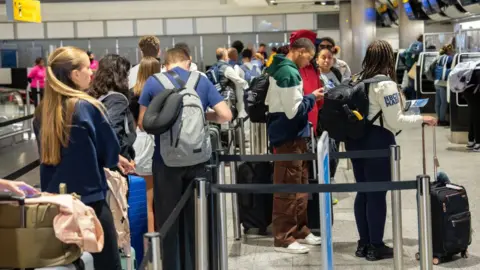Business reporter, BBC News
 Getty Images
Getty ImagesA radar problem used within the UK’s air traffic control system caused chaos at airports in the UK and beyond on Wednesday.
The fault lasted a mere 20 minutes, but was enough to ground planes across the country, causing 150 flight cancellations and delays that have continued into Thursday.
So, what went wrong with this vital piece of air traffic technology?
NATS, which is partly owned by the government, manages all of the UK’s airspace for flights arriving and departing the country’s airports.
It has not provided lots of detail on Wednesday’s outage other than saying there was “radar-related issue which was resolved by quickly switching to the back-up system”.
It said it reduced traffic during the outage for safety reasons and added that “there is no evidence” that it was caused by any cyber attack.
Transport Secretary Heidi Alexander has said NATS told her it was “an isolated event and there is no evidence of malign activity”.
To understand how such a brief radar failure could cause such much havoc, Graham Lake, a former director general of the Civil Air Navigation Services Organisation (CANSO), said people should imagine the NATS air traffic network as “national infrastructure”.
“Think of the network as motorways in the sky,” he told the BBC.
“When you lose something like surveillance radar coverage for whatever reason, the capability of your network degrades to a country lane.
“That’s why the systems slow down when there’s a technical failure.”
Is NATS to blame for the outage?
Airlines have been vocal in their criticism of NATS, noting that this is the second time its system has failed since 2023.
In August 2023, more than 700,000 passengers were affected when some 500 flights were cancelled at the UK’s busiest airports due to a major outage.
One airline, Ryanair, has called for NATS chief executive Martin Rolfe to resign, arguing “no lessons” have been learned from the previous failure.
Easyjet has called the outage “extremely disappointing”.
However, Mr Lake told the BBC’s Today programme he did not believe it was fair to call for Mr Rolfe to lose his job, arguing that technical failures are “inevitable” and that “the recovery was quick”.
Even with the issues in 2023, NATS has been performing well “if you look at the minutes of outage over a period of years”, he said.
Are the UK’s skies just too busy?
Mr Lake said that the NATS performs well when compared with other countries – which also suffer from air traffic glitches – and that Wednesday’s issue was a case of bad luck.
“The UK airspace is very busy, certainly among the busiest in the world. We are at the busiest time of year and the failure yesterday was at the busiest time of day, so it’s not an ideal situation.”
Because of the congestion in the UK’s skies, Heathrow Airlines Operators Committee, which represents airlines that fly from the airport, has called for more runways in the south east of England to increase capacity.
The group’s chief executive Nigel Wicking said “the NATS operational teams do a phenomenal job” but that the system is “running hot” and “when things go wrong and we lose the system for even an hour the impact is major”.
The UK government has said it backs the expansion of Heathrow, Gatwick, and Luton airports, but critics argue the plans would increase emissions and air pollution.
Source link
 Unews World
Unews World
